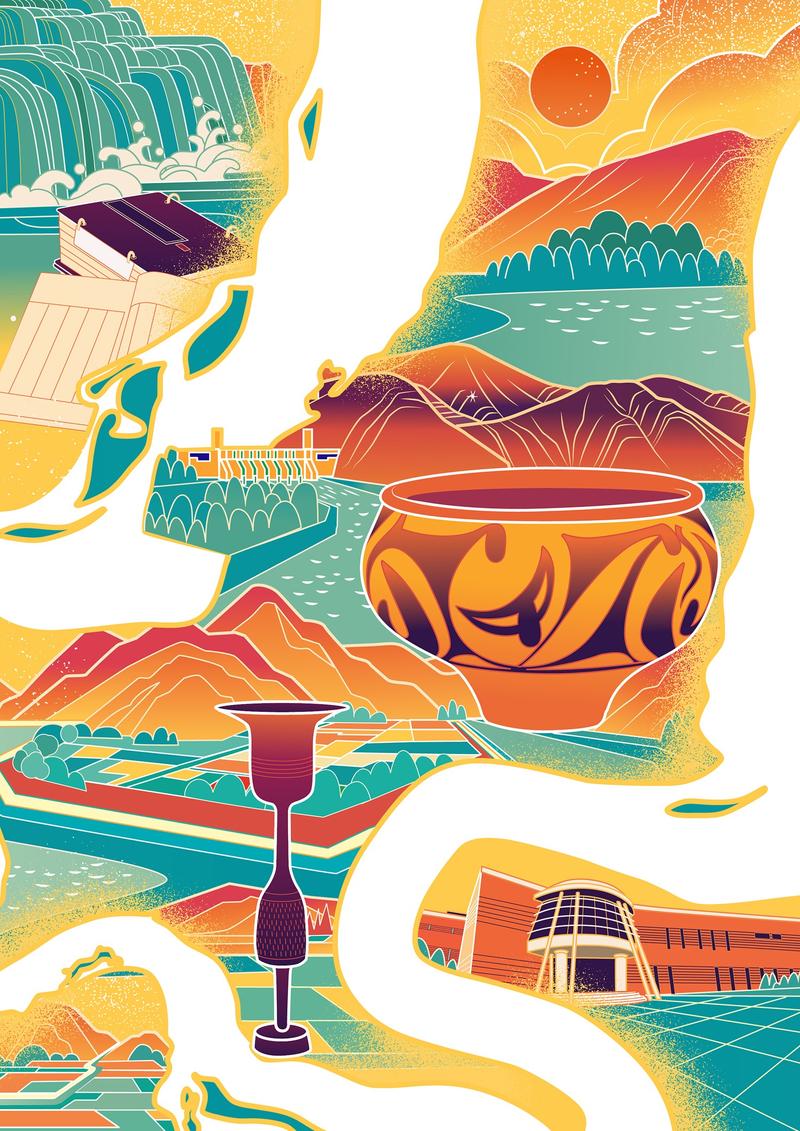Guideline calls for safeguarding of ancient waterway's cultural treasures
 (SHI YU / CHINA DAILY)
(SHI YU / CHINA DAILY)
Snaking through 69 cities in nine provinces and autonomous regions across North China, the 5,464-kilometer-long Yellow River is an age-old witness to the nation's history.
Over the course of around 5,000 years of Chinese civilization, different regions along the river have served as important political and cultural centers. Over 300,000 cultural heritage sites are located along the length of the Yellow River, comprising about 40 percent of the national total, according to the National Cultural Heritage Administration.
Methods for better protecting these sites have been a concern for generations of conservators.
Last month, a national-level guideline on the protection and use of cultural heritage along China's "mother river" was jointly released by the National Cultural Heritage Administration and several other ministries. It outlines a wide spectrum of work that should be carried out, ranging from archaeology and academic studies, to conservation efforts and the exhibition of Yellow River relics.
"From the cities of Chang'an (today's Xi'an) and Luoyang to Zhengzhou and Kaifeng, the middle reaches of the Yellow River bred the 'axis age' of ancient China," said Liu Qingzhu, a veteran archaeologist at the Chinese Academy of Social Sciences.
"The river created the foundations of Chinese civilization," he said. "By better protecting and understanding Yellow River cultures, we can further trace our origins and enhance our sense of identity."
The guideline also stressed the need to bolster archaeological research along the river, particularly research centered on tracing the origins of Chinese civilization through prehistoric stone cities and core settlements.
For example, the 4,000-year-old Shimao stone city in Shaanxi province is the largest ruined city from the era ever found in China. The Erlitou site in Henan province is widely believed to be the capital of the Xia Dynasty (c. 21st to 16th century BC), the first central dynasty recorded in Chinese history.
According to a statement released by the National Cultural Heritage Administration further explaining the guideline, a series of key archaeology laboratories, museums and warehouses for storing archaeological artifacts will be established in provinces and regions the Yellow River meanders through.
"Professional archaeological institutions in provinces like Shaanxi, Shanxi, Shandong and Henan will be transformed into top-tier institutes of their kind," the statement said.
The conservation of ancient grotto temples, which played a vital role not only in the spread of Buddhism in China, but also in cross-cultural communication along the Silk Road, is another of the guideline's key focuses.
The protection of the grottoes, and other ancient architecture along the river, can contribute to the development of new materials and technologies, the guideline pointed out.
"The conservation and utilization of cultural heritage along the Yellow River have long been troubled by the fact that studies lack coordination (between different regions and departments)," said Zhang Binyuan, chief engineer of the Henan Provincial Cultural Heritage Administration. "Furthermore, many grassroots institutions lack the expertise and personnel for management and exhibition, and our explanation of the value of the Yellow River needs to be improved. The guideline is a source of confidence for conservators in the regions along the river."
Systems for better coordination among provinces and government departments concerning the Yellow River were also recently established following the guideline.
In July, an alliance to protect grotto temples was set up in Shanxi to coordinate efforts across six provinces.
In Shandong, a series of archaeological research endeavors and cultural heritage restoration programs will be launched in the lower reaches of the river, joining efforts by administrations overseeing cultural heritage and water resources.
"Yellow River artifacts have been pivotal to our last few years of work," said Wang Lei, director of the Shandong Provincial Cultural Heritage Administration. "Detailed plans are still being drafted, and a comprehensive and scientific system to better protect them in the long term is needed."
Ultimately, the work being carried out to protect heritage should benefit the public. In Lanzhou, capital of Gansu province, an exhibition opened at the Gansu Provincial Museum in June displaying 300 artifacts from prehistoric Yellow River cultures to show how ancient civilizations overcame difficulties and thrived.
In July, another exhibition of artifacts from all nine provincial-level administrative regions along the river was launched at the Shaanxi History Museum in Xi'an to show the river's lasting influence on the cultures, philosophies and literature it nurtured.
Nevertheless, as the new guideline indicates, more needs to be done to tell these stories to a broader audience. For example, it encourages regular international cooperation among the institutions of the Yellow River and of those famed waterways such as the Nile, the Indus, the Ganges and the Euphrates.
As the National Cultural Heritage Administration statement elaborated, cooperation would involve the conservation of relics, archaeological efforts and exhibitions to contribute to the study of the origins of the world's civilizations, and the development of an international think tank on heritage conservation. This would also provide more opportunities for cultural heritage from the Yellow River to be exhibited overseas.


